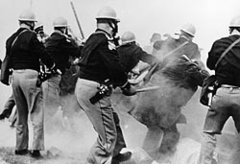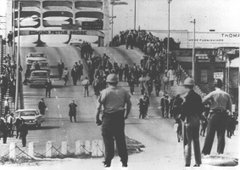Selma to Montgomery marches
|
|
Selma_to_Montgomery_marches.jpg
The Selma to Montgomery marches, which included Bloody Sunday, were three marches that marked the political and emotional peak of the American civil rights movement. They were the culmination of the movement in Selma for voting rights, launched by Amelia Boynton Robinson and her husband, who brought many prominent leaders of the American Civil Rights Movement to Selma, including Martin Luther King Jr., Jim Bevel, and Hosea Williams.
The first march occurred on "Bloody Sunday", March 7, 1965, when 600 civil rights marchers were attacked by state and local police with billy clubs and tear gas. Only the third, and last, march successfully made it into Montgomery. The route is memorialized as the Selma to Montgomery National Trail.
| Contents |
Bloody Sunday - the first march
On March 7, 1965, 525 to 600 civil rights marchers headed east out of Selma on U.S. Highway 80. Discrimination and intimidation had prevented Selma's black population, roughly half of the city, from registering and voting; three weeks earlier, February 18, 1965, a trooper shot Jimmie Lee Jackson as he tried to protect his mother in a civil rights demonstration. He died of a massive infection at Selma's Good Samaritan Hospital eight days later. The marchers hoped to bring notice to the violations of their rights by marching to the state capitol in Montgomery.
In their first march, led by the Reverend Hosea Williams, they made it only as far as the Edmund Pettus Bridge, six blocks away. State troopers and the Dallas County Sheriff's Department, some mounted on horseback, awaited them. In the presence of the news media the lawmen attacked the peaceful demonstrators with billy clubs, tear gas, and bull whips, driving them back into Selma.
Brutal televised images of the attack, which left many bloodied and severely injured, roused support for the US civil rights movement. Amelia Boynton Robinson was beaten and gassed nearly to death -- her photo appeared on the front page of papers and newsmagazines around the world. Seventeen marchers were hospitalized, leading to the naming of the day, "Bloody Sunday".
The second march
Immediately after "Bloody Sunday" Martin Luther King Jr., as leader of the Southern Christian Leadership Conference, began organizing a second march to be held on Tuesday, March 9, 1965, calling for people across the country to join him. Hundreds of people responded to his call, shocked by what they had seen on television.
To prevent another outbreak of violence the marchers attempted to gain a court order that would prohibit the police from interfering. Instead of issuing the court order Federal District Court Judge Frank M. Johnson, Jr. issued a restraining order, preventing the march from taking place until he could hold additional hearings later in the week.
Rather than abiding by the court order the SCLC decided to hold a partial, "ceremonial", march, taking into consideration that they had gathered hundreds of marchers for the event, but did not want to alienate one of the few southern judges who was often sympathetic to their cause.
On March 9th King led the marchers out to the Edmund Pettus Bridge and held a short prayer session before turning the marchers back around, thereby not breaking the court order preventing them from marching all the way to Montgomery. Only the SCLC leaders were told of this plan, causing some consternation in the marchers who had traveled long distances to make the march, but many stayed after King asked the crowd to remain for another attempt at the march.
On March 9, after the second march, James Reeb, a white Unitarian Universalist minister from Boston who had come for the second march and had agreed to stay, was attacked with a club in front of the Silver Moon Café, a hangout for whites. Being turned back by the small local hospital in Selma (reported to be full at the time), Reeb's companions were forced to take him to University Hospital in Birmingham, two hours away. Reeb died on Thursday, March 11, at University Hospital with his wife by his side.
Reeb's death garnered national attention, much to the chagrin of some blacks after the death of Jimmie Lee Jackson went largely unnoticed. Student Nonviolent Coordinating Committee spokesperson Stokely Carmichael was reported as saying "What you want is the nation to be upset when anybody is killed . . . but it almost [seems that] for this to be recognized, a white person must be killed".
The third march
A week after Reeb's death, the federal judge ruled in favour of the SCLC, preventing the State from blocking the marchers, weighing the right of mobility against the right to march:
- The law is clear that the right to petition one's government for the redress of grievances may be exercised in large groups . . . and these rights may be exercised by marching, even along public highways.
Exactly two weeks, March 21, 1965, after Bloody Sunday, about 3,200 marchers set out from Selma to Montgomery, about 50 miles away. They walked about 12 miles (20 km) a day, sleeping in fields at night. They reached Montgomery on March 24 and camped out at the Catholic complex City of St. Jude. That night, a "Stars for Freedom" rally was held, with singers Harry Belafonte, Tony Bennett, Peter, Paul and Mary, and Sammy Davis Jr. all performing.
By the time they reached the capitol the next day, Thursday, March 25, their numbers had swollen to 25,000, and King delivered the speech "How Long, Not Long" from the capitol steps.
Within five months of the third march, President Lyndon Johnson signed the Voting Rights Act of 1965. Amelia Boynton Robinson was present during the ceremony.
External links
- Veterans of the Civil Rights Movement -- Images of Selma (http://www.crmvet.org/images/imgselma.htm)
- Civil Rights Marches (http://www.yubanet.com/artman/publish/article_21783.shtml)
- Police attack Alabama marchers (http://news.bbc.co.uk/onthisday/hi/dates/stories/march/7/newsid_4318000/4318021.stm) (BBC News)
- Alabama Department of Archives & History (http://www.alabamamoments.state.al.us/sec59det.html)
- The Selma Times-Journal. March 11, March 12, and March 14, 1965, editions.


